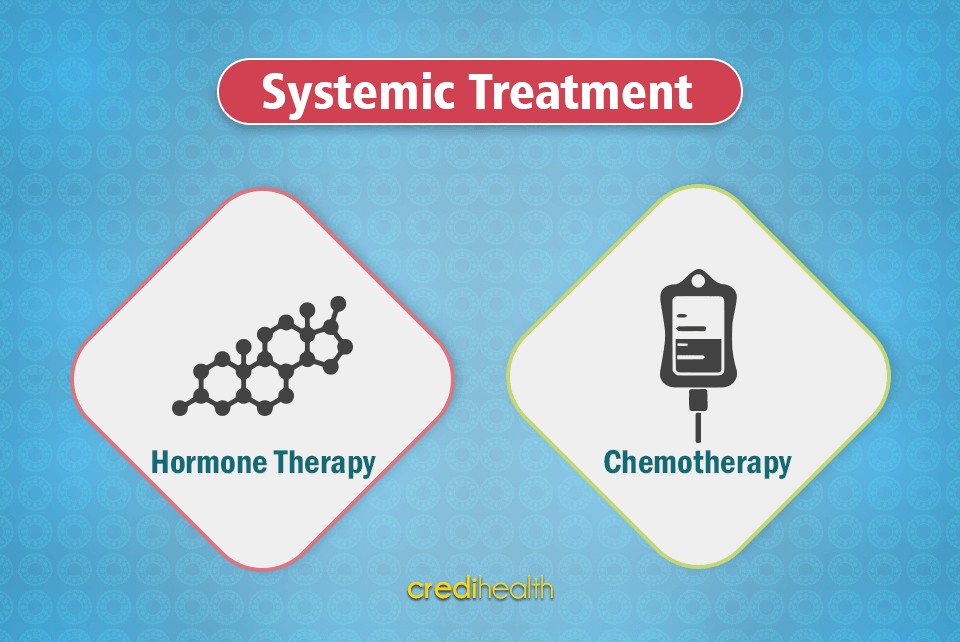Breast cancer is a leading of death among women all over the world. However, it is surprising that if detected early, breast cancer is most often curable. Therefore, awareness about the various breast cancer stages can help in a timely and proper diagnosis and treatment. You can consult with an Oncologist for the treatment of breast cancer.



Breast Cancer Staging, Diagnosis and Treatment

Screening & Diagnosis of Breast Cancer
Breast Cancer is curable if treated early. The survival rate of Breast Cancer is more than 95% if treated at stage 0, I & II. Be aware and take action at an early stage. Screening of the cancer is done on symptom-free woman/man, apparently on healthy people with the main aim of diagnosing the disease early. Although screening doesn't prevent breast cancer, it can help in early diagnosis.Types of Screening:
- Mammogram: It is the X-ray of your breast. It is the best way to diagnose this cancer early when it can be treated easily.
- Breast Exam: The physician will check both the patient's breasts, looking out for lumps and other possible abnormalities, such as inverted nipples, nipple discharge, or change in breast shape. The patient will be asked to sit/stand with her arms in different positions, such as above her head and by her sides.
- Stand with shoulders straight and arms on hips. Now see your breasts in the mirror.
- Check for size, shape, and color. If you notice bulging or dimpling of the breasts' skin, distorted shape, inverted nipple, redness, soreness, swelling or rash, speak to your doctor.
- Raise your arms and check for changes same as above.
- Look for any signs of fluid coming out of nipples. It could be clear or milky, even blood-stained sometimes.
- Now feel your entire breast in small circular movements while lying down. Touch left breast with a right hand and right breast with a left hand.
- Do this once again while standing.
Diagnosis of Breast Cancer
The sooner breast cancer is screened or diagnosed, the better are the chances of having a successful treatment. Usually, the diagnosis of breast cancer happens after a regular screening or after certain breast cancer symptoms appear. Initially, a primary care doctor carries out a physical exam, and then refer the patient to a specialist if he/she thinks the further assessment is needed.- Breast ultrasound: In the diagnosis of breast cancer, sound waves are used to develop images of structures deep within the body. This can be used to determine whether a new breast lump is a solid mass or a fluid-filled cyst.
- Removing a sample of breast cells for testing (biopsy): This is the only certain method for the definitive diagnosis of breast cancer. A biopsy sample is analyzed to determine whether the cells are cancerous or not, the type of cells involved in the breast cancer, the extent of the cancer.
- Breast magnetic resonance imaging (MRI): Before MRI, a dye is injected into the body and then magnet and radio waves are used to produce pictures of the interior of the breast.
Breast Cancer Stages & Treatment
Once the cancer is diagnosed, the cancer specialist now works to find out the breast cancer stages which helps in determining the best treatment options. Breast cancer treatment options are determined on the basis of the types of breast cancer, breast cancer stages, and size of the tumor. The patient's own preference is also considered along with his/her overall health.Breast Cancer Stages:
The different breast cancer stages alert a patient about the extent of cancer that has spread within their body. By knowing the stage of breast cancer, one is at, helps to plan a proper and timely diagnosis followed by successful treatment. And, in general, the earlier the stage, the better the prognosis will be. The way to study breast cancer stages is through various pathology tests along with tests such as mammography are used to study the size of the tumor, how much it's spread, and what should be the required prognosis. The breast cancer stages range from 0 to 4. And, the stage depends on the combination of tumor size, lymph node status, and metastases. The different breast cancer stages are mentioned below:How many breast cancer stages are there?
- Stage 0 In stage zero, there is no sign of cancer cells or non-cancerous abnormal cells present in the breast tissues or spreading through to neighboring tissues.
- Stage I In stage one cancerous cells start propping up in the breast tissue and breaking through to or invading surrounding normal tissue. This stage is divided into two subcategories known as IA and IB.
- Stage IA: • The cancer cell/tumor measures up to 2 centimeters and, • The cancer cell/ tumor has not spread outside the breast & no lymph nodes are involved
- Stage IB: • There is no tumor in the breast; instead, small groups of cancer are present in the lymph nodes • There is a tumor on the breast and there are small groups of cancer cells in the lymph nodes
-
Stage II: This stage is divided into two subcategories known as IIA and IIB.
- Stage IIA: • No cancerous cells found in the breast, however, cancer is found in the lymph nodes under the arm or near the breastbone, Or • The tumor is small in size but has spread to the axillary lymph nodes, Or • The tumor is larger in size (but less than 5 centimeters) but has not spread to the axillary lymph nodes
- Stage IIB: • The size of the tumor ranges from 2 to 5 cms and the small groups of breast cancer cells range from 0.2 to 2 mm are present in the lymph nodes, Or • The size of the tumor ranges from 2 to 5 cms and cancer has spread up to 3 axillary lymph nodes or nodes near the, Or • The size of the tumor is greater than 5 cm, however, it has not spread to the axillary lymph nodes.
-
Stage III: This stage is divided into three subcategories known as IIIA, IIIB, and IIIC.
- Stage IIIA: • Either no cancer cells are found in the breast or cancer may present in any size or cancer is found axillary or lymph nodes OR • The size of the breast cancer cell tumor is greater than 5cm and/or small groups of breast cancer cells are present in the lymph nodes OR • The size of the cancer cell is greater than 5cm and/or cancer has spread up to 3 axillary lymph nodes or to the lymph nodes near the
- Stage IIIB: • The size of the cancer cell can be of any size, that has spread in and around the breast tissues or wall, and • Cancer may have spread up to 8 axillary lymph nodes, Or • Cancer may have spread to lymph nodes near the breastbone as well
- Stage IIIC: • There may be no sign of breast and if it is present, it can be of any size and may have spread to any part of the breast cell, tissue, wall, etc, and, • Cancer has spread and invaded into at least 10 axillary lymph nodes, or, • Cancer has spread and invaded into the lymph nodes around the collarbone, Or, • Cancer has spread to axillary lymph nodes or to lymph nodes near the breastbone
- Stage IV Stage IV stands for invasive breast cancer that has invaded not only into the breast but also to the nearby lymph nodes to other organs of the body. One should remember that, the greater the stage, the lower the prognosis.
Various Breast Cancer Treatment Options


-
Breast Cancer Surgery: Surgical procedures involved in the breast cancer treatment are:
- Removing the breast tumor: In this procedure, also known as lumpectomy, tumor and a very small surrounding healthy tissue is removed.
- Removal of the entire breast: This operation involves the removal of the entire breast tissue- the lobules, ducts, fatty tissue including some skin- areola and nipple.
- Lymph nodes removal: If your cancer has spread into the senital lymph nodes, then removal of lymph nodes in your armpit might be considered as a breast cancer treatment option. Complications associated with the surgery of breast includes pain, bleeding, infection and arm swelling.
- Radiation Therapy: In this high-powered beams of energy like X-rays or protons are used to destroy cancerous cells. External beam radiation is generally used after removal of a tumor in early-stage breast cancer treatment. Side effects of this therapy include fatigue, red blotches, swelling and sometimes serious effects like heart or lungs damage.
- Chemotherapy: In this therapy, use of drugs are involved to kill cancer cells and doctors recommend for chemotherapy when there is a high risk of cancer to spread to other parts of the body. This is breast cancer treatment also used to shrink the size of the tumor before removal surgery. Side effects are hair loss, vomiting, nausea, fatigue, premature menopause, infertility etc.
Alternative Medicine
Although no alternative medication has been found to cure breast cancer, there are therapies which may help in coping up with the breast cancer symptoms, side effects of the breast cancer treatment are mentioned below: 1. Gentle exercise 2. Meditation 3. Yoga To learn more about how to prevent breast cancer naturally by implementing certain lifestyle changes, go to the How to Prevent Breast Cancer Naturally article.
Reviewed by







